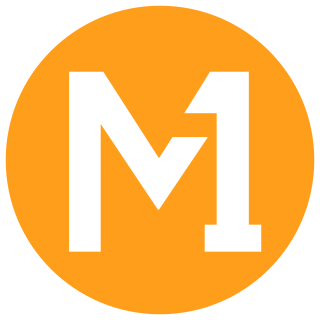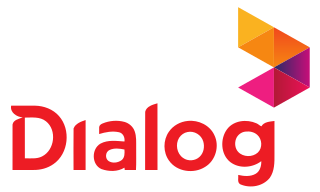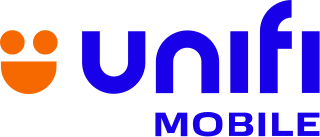Related Research Articles
The primary regulator of telecommunications in Malaysia is the Malaysian Communications and Multimedia Commission (MCMC). It issues licenses under the Communications and Multimedia Act 1998, the Postal Services Act 2012 and the Digital Signature Act 1997.

Celcom Axiata Berhad is the oldest mobile telecommunications provider in Malaysia. Celcom is a member of the Axiata group of companies. Celcom was merged with Digi to form CelcomDigi on 1 December 2022.

3G is the third generation of wireless mobile telecommunications technology. It is the upgrade over 2G, 2.5G, GPRS and 2.75G Enhanced Data Rates for GSM Evolution networks, offering faster data transfer, and better voice quality. This network was superseded by 4G, and later on by 5G. This network is based on a set of standards used for mobile devices and mobile telecommunications use services and networks that comply with the International Mobile Telecommunications-2000 (IMT-2000) specifications by the International Telecommunication Union. 3G finds application in wireless voice telephony, mobile Internet access, fixed wireless Internet access, video calls and mobile TV.
4G is the fourth generation of broadband cellular network technology, succeeding 3G and preceding 5G. A 4G system must provide capabilities defined by ITU in IMT Advanced. Potential and current applications include amended mobile web access, IP telephony, gaming services, high-definition mobile TV, video conferencing, and 3D television.

Telekom Malaysia Berhad or simply TM is a Malaysian telecommunications company founded in 1984. Beginning as the national telecommunications company for fixed line, radio, and television broadcasting services, it has evolved to become the country's largest provider of broadband services, data, fixed line, pay television, and network services. TM ventured into the LTE space with the launch of TMgo, its 4G offering. TM's 850 MHz service was rebranded as unifi Mobile in January 2018.

M1 Limited is a Singaporean telecommunications company and one of the major telcos operating in the country. M1 was founded in 1994 and traded on the Singapore Exchange from 2002 to 2019. M1 is a subsidiary of the Keppel Corporation and Singapore Press Holdings through their joint venture, Konnectivity.

Dialog Axiata PLC, is one of Sri Lanka's largest telecommunications service providers, and the country's largest mobile network operator with over 17 million subscribers which amounts to 57% of the Sri Lankan mobile market. Dialog is a subsidiary of Axiata Group Berhad which owns 83.32% controlling stake of the company, while the rest is held by the public.

This article is intended to give an overview of the history of telecommunications in Malaysia.

Sri Lanka Telecom PLC, doing business as SLT-MOBITEL, is the national telecommunications services provider in Sri Lanka and one of the country's largest companies with an annual turnover in excess of Rs 40 billion. The company provides domestic and corporate services which include fixed and wireless telephony, Internet access and IT services to domestic, public and business sector customers. As of 2018 SLT-MOBITEL was Sri Lanka's second largest mobile network operator with over 7.9 million subscribers.

The Internet in South Africa, one of the most technologically resourced countries on the African continent, is expanding. The internet country code top-level domain (ccTLD) .za is managed and regulated by the .za Domain Name Authority (.ZADNA) and was granted to South Africa by the Internet Corporation for Assigned Names and Numbers (ICANN) in 1990. Over 60% of Internet traffic generated on the African continent originates from South Africa. As of 2020, 41.5 million people were Internet users.
Before the era of internet business in Indonesia, internet connections could only be found at a few leading universities. By using UUCP, university servers in Indonesia exchange information with other university servers in the world through their respective gateways. In 1994, the internet business in Indonesia was started, marked by the granting of an internet service provider (ISP) company license issued by the Indonesian government to PT. Rahajasa Media Internet or RADNET.

See also: Maxis, CelcomDigi, Yes, Unifi
In Romania, there are 18.8 million connections to the Internet. Romania's country code is .ro. The .eu domain is also used, as it is shared with other European Union member states. There were over 600 000 domains registered under .ro at the end of 2012.

Unifi Mobile is a Malaysian internet service provider and the country's sixth mobile network operator. Originally known as Packet One Networks (P1), the company was founded on 11 February 2002 and is currently a subsidiary of the national telephone company, Telekom Malaysia.
International Mobile Telecommunications-Advanced are the requirements issued by the ITU Radiocommunication Sector (ITU-R) of the International Telecommunication Union (ITU) in 2008 for what is marketed as 4G mobile phone and Internet access service.

A mobile broadband modem, also known as wireless modem or cellular modem, is a type of modem that allows a personal computer or a router to receive wireless Internet access via a mobile broadband connection instead of using telephone or cable television lines. A mobile Internet user can connect using a wireless modem to a wireless Internet Service Provider (ISP) to get Internet access.

YTL Communications or YTL Communications Sdn. Bhd.dbaYes is a mobile network operator in Malaysia, the fifth in the country overall. Headquartered in Kuala Lumpur, Malaysia, YTL Communications is a subsidiary of the utilities company YTL Power International Berhad and serves as the communications arm of YTL Corporation Berhad, a leading infrastructure conglomerate in Malaysia. Yes uses the native dialling prefix identifier of 018 and 011-1.

Airtel India commonly known as Airtel, is the second largest provider of mobile telephony and third largest provider of fixed telephony in India, and is also a provider of broadband and subscription television services. The brand is operated by several subsidiaries of Bharti Airtel, with Bharti Hexacom and Bharti Telemedia providing broadband fixed line services and Bharti Infratel providing telecom passive infrastructure service such as telecom equipment and telecom towers. Currently, Airtel provides 5G, 4G and 4G+ services all over India. Currently offered services include fixed-line broadband, and voice services depending upon the country of operation. Airtel had also rolled out its VoLTE technology across all Indian telecom circles.
References
- ↑ "Malaysia profile: Media", BBC News, 10 September 2013. Retrieved 27 January 2014.
- ↑ "Communications and Multimedia : Facts and Figures, 1Q 2017", Malaysian Communications and Multimedia Commission, 2 August 2017, retrieved 12 September 2017
- ↑ Sreejit Pillai (13 November 2001). "M'sia oldest search engine upbeat in trying times". ZDNet . Retrieved 8 July 2011.
- ↑ Beta Interactive Services, 1996
- ↑ Lee, 2000c
- ↑ "Drivers and Impediments to E-commerce in Malaysia", John Paynter and Jackie Lim, Malaysian Journal of Library & Information Science, Vol.6, no.2, December 2001: 1-19. Retrieved 28 January 2013.
- ↑ Salman Ali, Ah Choy Er, Amizah Wan Mahmud Wan, Abdul Latif Roslina (2013). "Tracing the Diffusion of Internet in Malaysia: Then and Now". Asian Social Science. 9 (6). doi: 10.5539/ass.v9n6p9 .
{{cite journal}}: CS1 maint: multiple names: authors list (link) - ↑ "Malaysia's Mobile and Broadband Internet Speeds". Speedtest Global Index - Malaysia.
- ↑ "Malaysia, September 2023, Mobile Network Experience Report | Opensignal". www.opensignal.com. Retrieved 6 November 2023.
- ↑ Barton, James (1 October 2019). "Malaysia set to trial 5G in six states". Developing Telecoms. Retrieved 21 October 2021.
- ↑ "5G rollout in 3 cities by year-end", The Malaysian Reserve. 7 July 2021, Retrieved 21 October 2021.
- ↑ "Digi Malaysia 3G shutdown".
- ↑ "TM confirms signing up for 5G trials with DNB". The Star. Retrieved 9 January 2022.
- ↑ "TM to migrate Streamyx users to Unifi Lite at RM69 a month; offers Unifi Air as alternative". The Star. Retrieved 20 October 2021.
- ↑ "TM To Launch HSBB Retail Service March 24". Bernama. 17 March 2010. Archived from the original on 2 February 2014. Retrieved 26 March 2010. Alt URL
- ↑ "TM Invests RM1.9 Billion, To Date, To Develop HSBB". Bernama. 18 March 2010. Archived from the original on 29 June 2011. Retrieved 26 March 2010.
{{cite news}}: CS1 maint: bot: original URL status unknown (link) - ↑ "Check Coverage | Time Internet". Time. Retrieved 6 November 2023.
- ↑ "Digi Help Centre | FAQ, Guides & How-Tos for Postpaid, Prepaid, Broadband & Devices". help.digi.com.my. Retrieved 6 November 2023.
- ↑ "Residential Coverage - Allo Wifi" . Retrieved 20 October 2021.
- ↑ "How To Get Digi Wi-Fi". community.digi.com.my. 3 December 2018. Retrieved 20 October 2021.
- ↑ wifi@unifi FAQ, Telekom Malaysia / unifi. February 24, 2020, retrieved on October 20, 2021.
- ↑ Yeoh, Angelin. "YTL completes Terragraph trial, now offers free public WiFi at 50 locations in George Town". The Star. Retrieved 20 October 2021.
- ↑ "WiFi Smart Selangor - SMARTSEL Sdn Bhd". smartsel.co. Retrieved 11 June 2022.
- ↑ penangfreewifi.com.my now redirects to wp.redtone.com.
- ↑ "Penang Free Wifi". penangfreewifi.com.my. 11 January 2019. Archived from the original on 11 January 2019. Retrieved 20 October 2021.
- ↑ "Free wifi service in Penang to be suspended from Feb 13". www.thesundaily.my. Retrieved 20 October 2021.
- ↑ "MCMC wants block of 10 websites that allow illegal movie downloads", Wong Pek Mei, Star Online, 10 June 2011. Retrieved 27 January 2014.
- ↑ "Malaysian Govt Orders ISPs to Block Pirate Bay, Megaupload" Archived 2012-05-23 at the Wayback Machine , Jared Moya, ZeroPaid, 10 June 2011. Retrieved 28 January 2014.
- ↑ "No censorship of the Internet", Lester Kong and Zulkifli Abd Rahman, The Star, 8 August 2009. Retrieved 28 January 2014.
- ↑ "JENDELA Program". myjendela.my. Retrieved 2 January 2021.
- ↑ "JENDELA FAQ - What is the Lab outcome that has transpired into JENDELA?".
- ↑ "Imgur - Photos of Best Trace from TM Network to China Telecom Server". 2 January 2020.
- ↑ "Imgur - Best Trace to Cloudflare IP from TM network". 2 January 2020.
- ↑ "Masalah Sambungan Unifi Ke Server Singapore". 8 June 2021.